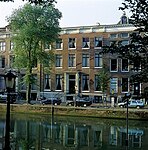KattenKabinet
1990 establishments in the NetherlandsArt museums and galleries in the NetherlandsCats in artCats in popular cultureMuseums established in 1990 ... and 1 more
Museums in Amsterdam

The KattenKabinet ("Cat Cabinet") is an art museum in Amsterdam devoted to works depicting cats. The museum collection includes paintings, drawings, sculptures and other works of art by Pablo Picasso, Rembrandt, Henri de Toulouse-Lautrec, Corneille, Sal Meijer, Théophile Steinlen, and Jože Ciuha, among others. The museum is housed in a canalside building at Herengracht 497, in the grand Gouden Bocht ("Golden Bend") of this canal. The owner lives on the second floor of the building with his family. There are some cats in the museum as well.
Excerpt from the Wikipedia article KattenKabinet (License: CC BY-SA 3.0, Authors, Images).KattenKabinet
Herengracht, Amsterdam Centrum
Geographical coordinates (GPS) Address Nearby Places Show on map
Geographical coordinates (GPS)
| Latitude | Longitude |
|---|---|
| N 52.365555555556 ° | E 4.8915277777778 ° |
Address
Herengracht 497G
1017 BT Amsterdam, Centrum
North Holland, Netherlands
Open on Google Maps









